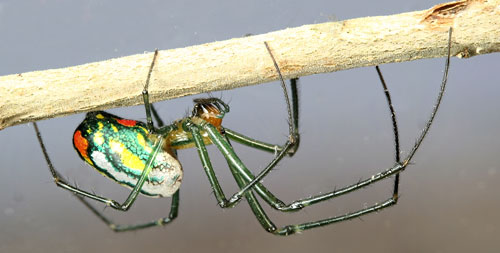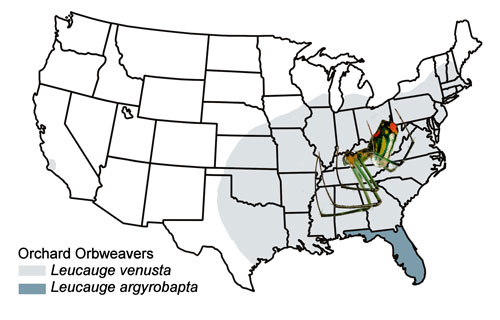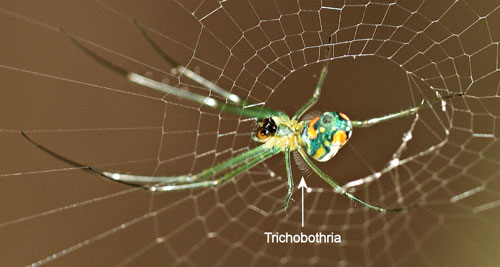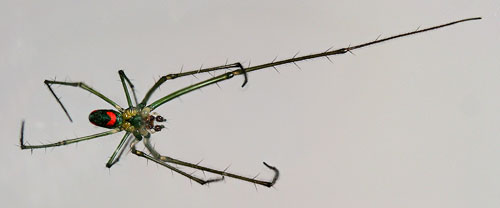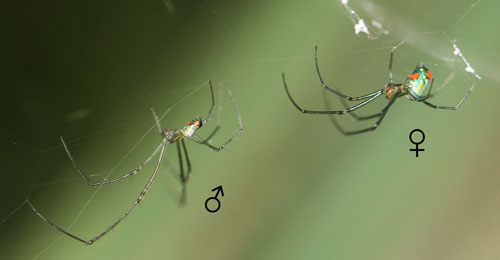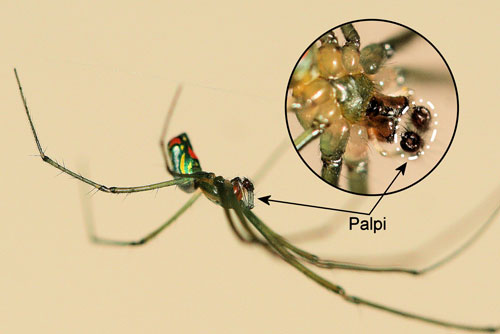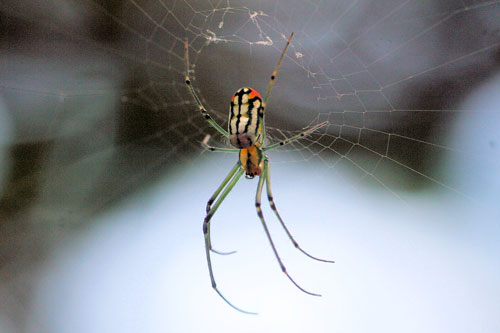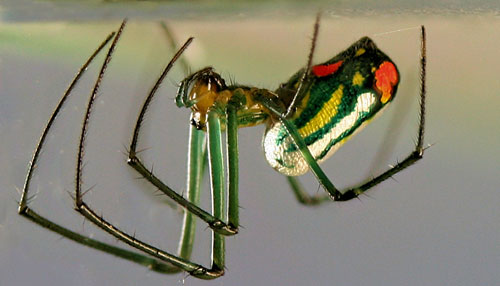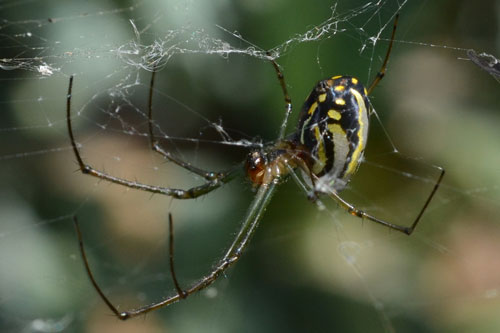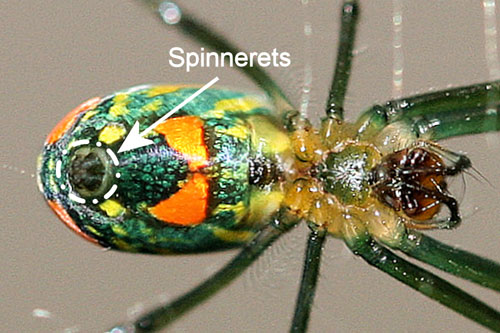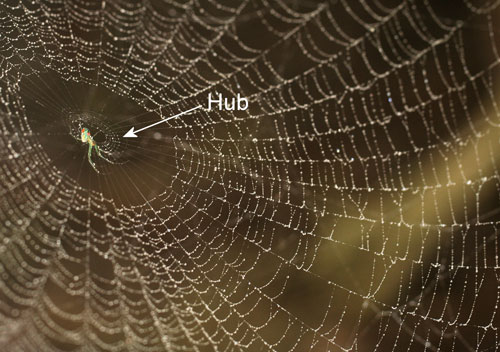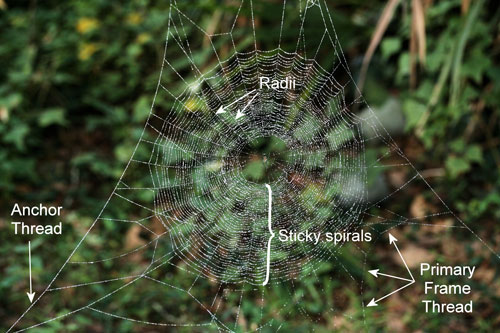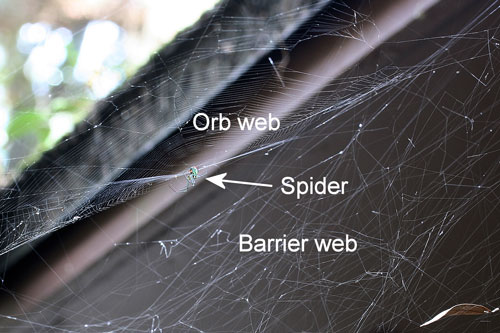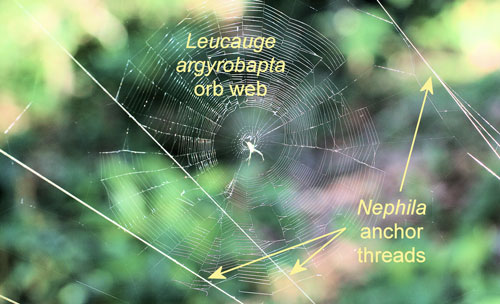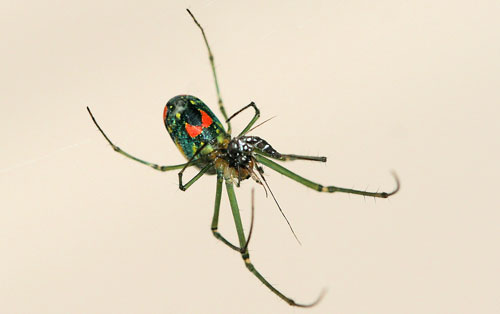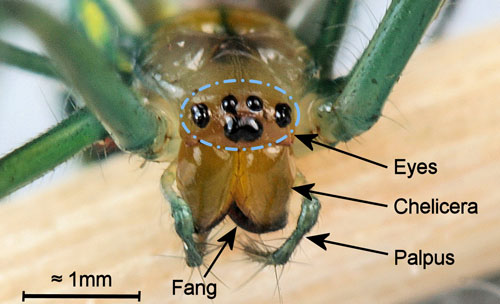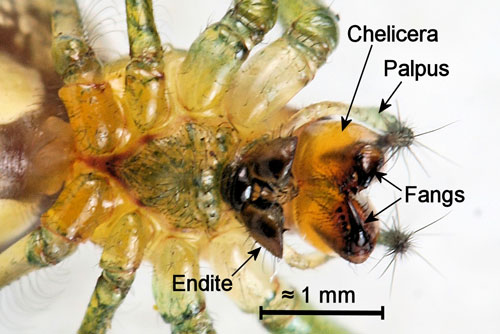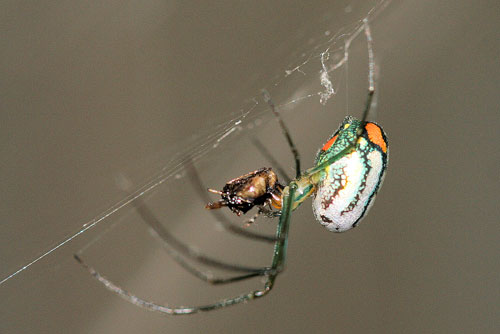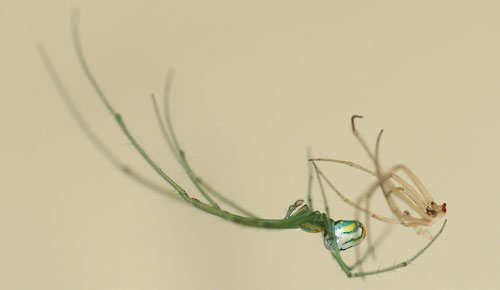common name: orchard orbweaver, orchard spider
scientific name: Leucauge argyrobapta (White), Leucauge venusta (Walckenaer) (Arachnida: Araneae: Tetragnathidae)
Introduction - Synonymy and Nomenclature - Distribution - Description - Behavior - Enemies - Selected References
Introduction (Back to Top)
The orchard orbweavers, Leucauge argyrobapta (White) (Figure 1) and Leucauge venusta (Walckenaer), are attractive small spiders and collectively are some of the most common spiders in the eastern U.S. The name orchard orbweaver is the common name accepted by the American Arachnological Society Committee on Common Names of Arachnids (Breen 2003) for these species, but they have also been called simply orchard spiders (Kaston and Kaston 1953, Levi and Levi 2002). Orchard orbweavers belong to the family Tetragnathidae, the longjawed orbweavers (Levi and Hormiga 2017, World Spider Catalog 2018).
Figure 1. Female orchard orbweaver, Leucauge argyrobapta (White). (Spider removed from web for photography). Photograph by Donald W. Hall, University of Florida.
Synonymy and Nomenclature (Back to Top)
Synonyms for Leucauge venusta (Walckenaer):
Epeira venusta Walckenaer, 1841
Epeira hortorum Hentz, 1847
Argyroepeira hortorum Emerton, 1884
Argyroepeira venusta McCook, 1893
Leucauge (Argyroepeira) mabelae Archer, 1951
Linyphia (Leucauge) argyrobapta (White, 1841)
See Levi (1980, p. 25) for additional information on synonymy.
Historically, the distribution of Leucauge venusta (Walckenaer) was considered to range from Canada to Brazil. However, based on significant differences in DNA barcoding of populations, Ballesteros and Hormiga (2018) have proposed restricting the name venusta to temperate populations (Canada and U.S. north of Florida) and removing argyrobapta from junior synonymy to designate Florida populations from those throughout the remaining range of distribution to Brazil, which apparently comprise a cryptic species. According to Dimitrov and Hormiga (2010), Linyphia (Leucauge) argyrobapta is the type species of the genus Leucauge. Preliminary DNA barcoding data suggest that Leucauge argyrobapta may contain at least three additional cryptic species (Ballesteros and Hormiga 2018).
Distribution (Back to Top)
Leucauge argyrobapta is found in Florida and southward through the tropics to Brazil (Ballesteros and Hormiga 2018). Leucauge venusta, is found from Canada southward throughout the eastern half of the U.S.to Georgia with a small disjunct population in southern California. (Figure 2). The exact dividing line (and possible overlap) of the distributions of the two species is unknown.
Figure 2. Approximate distribution map for the orchard orbweavers, Leucauge argyrobapta (White) and Leucauge venusta (Walckenaer). Map based on Encyclopedia of Life (2018) map, Ballesteros and Hormiga 2018, and Levi 1980.
Description (Back to Top)
The genus name Leucauge is from Greek roots that literally mean “with a bright gleam” (Cameron 2017). Leucauge species can be differentiated from other tetragnathids by their oval bodies and reddish-orange triangular markings (Figure 3) on the ventral aspect (underside) of the abdomen. Because of the reddish-orange spots, some Leucauge species are occasionally mistaken for black widow spiders by the general public (Howell and Jenkins 2004, SpiderID 2016-2018). There are also proximal (close to the body) double rows of trichobothria (vibration-sensitive bristles) on the hind legs (Levi and Hormiga 2017) (Figure 4). The ventral reddish-orange area on males is shaped more like a transverse band (Figure 5).
Figure 3. Leucauge argyrobapta (White) female (underside). Note oval abdomen and reddish-orange triangular areas. Photograph by Donald W. Hall, University of Florida.
Figure 4. Leucauge argyrobapta (White) female. Note trichobothria. Photograph by Donald W. Hall, University of Florida.
Figure 5. Leucauge argyrobapta (White) male (underside). Note reddish-orange transverse band. Photograph by Donald W. Hall, University of Florida.
Leucauge argyrobapta and Leucauge venusta are nearly identical in appearance. There are very slight differences in the structure of the palpi of males, but the females are virtually indistinguishable (Ballesteros and Hormiga 2018). The specific epithet argyrobapta is from Greek roots that literally mean “baptized with silver” (Borror 1960). The specific epithet venusta is Latin for “charming” (Borror 1960).
Adults: Males (body length 3.5 to 4.0 mm) are smaller than females (body length 5.5 to 7.5 mm) (Edwards and Marshall 2002, Kaston and Kaston 1953), have longer legs (Figure 6) and conspicuous bulbous palpi that are much larger than those of females (Figure 7).
Figure 6. Leucauge argyrobapta (White) male and female. Photograph by Donald W. Hall, University of Florida.
Figure 7. Leucauge argyrobapta (White) male, side view. Inset: underside of cephalothorax (fused head and thorax). Note bulbous palpi. Photographs by Donald W. Hall, University of Florida.
The legs are green or greenish-black with black bands at the joints. The cephalothorax is tan. The abdomen is silvery-white with dark mid-dorsal (middle of the back), dorsolateral (area where back and sides of body meet), and lateral lines that run parallel for nearly the full length of the abdomen (Figure 8). In some specimens the mid-dorsal and dorsolateral lines are connected by transverse lines of varying thickness.
Figure 8. Leucauge argyrobapta (White) female (dorsal aspect). Photograph by Donald W. Hall, University of Florida.
There are yellow areas on the sides of the abdomen. In addition to the reddish-orange triangular ventral areas, there are dorsolateral reddish-orange spots near the end of the abdomen (Figure 9).
Figure 9. Leucauge argyrobapta (White) female (lateral aspect). (Spider removed from web for photography). Photograph by Donald W. Hall, University of Florida.
The silvery-white color is due to thin platelet-like guanine crystals (Oxford and Gillespie 1998, Alvarez-Padilla and Hormiga 2011, Gur et al. 2017) that reflect light. The dark lines and reddish-orange and yellow areas are due to overlaying pigments in the epidermis (Oxford and Gillespie 1998, Gur et al. 2017).
The only other Leucauge species in the eastern U.S. is Leucauge argyra (Walckenaer). Leucauge argyra has dark dorsal lines on the abdomen that turn inward at a 90-degree angle at mid-abdomen. Leucauge argyra also lacks the bright reddish-orange spots of the other two species (Bradley 2013) (Figures 10 and 11). Leucauge argyra females can also be separated from those of other Leucauge species by the cone-shaped epigynum (external genital structure of female spiders) (Levi 1980). Leucauge argyra is restricted to central and southern Florida in the U.S. (Levi 1980).
Figure 10. Leucauge argyra (Walckenaer) female (dorsal aspect). Photograph by Lyle J. Buss, University of Florida.
Figure 11. Leucauge argyra (Walckenaer) female (lateral aspect). Photograph by Lyle J. Buss, University of Florida.
Egg sacs and eggs: Levi (1980, p. 28) described an egg sac of Leucauge venusta from Virginia constructed of fluffy orange-white silk, measuring approximately 8 to 9 mm in diameter, and containing several hundred eggs. The eggs were reddish-orange and approximately 0.4 mm in diameter. The egg sac is commonly attached to a leave or twig near the edge of the web (Evans 2008).
Behavior (Back to Top)
Habitat: As the name implies, orchard orbweavers are commonly found in orchards. They are one of the most common spiders in Florida citrus groves (Muma 1975). However, both species are most commonly found in shrubby meadows and along woodland edges (Evans 2008). They are also common in wooded suburban areas of cities and often between hedges and houses under overhanging eaves. They are often gregarious and attach their webs together when prey is plentiful (Edwards and Marshall 2002).
Webs and Prey Capture: Silk for the webs is spun by spinnerets at the tip of the abdomen (Figure 12). Webs are usually horizontal (fewer than 45 degrees of slope) (Alvarez-Padilla and Hormiga 2011) but occasionally are nearly vertical (Evans 2008, Gregoric et al. 2013).
Figure 12. Orchard orbweaver, Leucauge argyrobapta (White), spinnerets. Photograph by Donald W. Hall, University of Florida.
Webs have a central hub of loops. The spider rests on the underside of the hub (Figure 13).
Figure 13. Orchard orbweaver, Leucauge argyrobapta (White), resting on underside of hub. (web misted with water for photography). Photograph by Donald W. Hall, University of Florida.
In addition to the hub, webs have supporting radii (typically 30 or more) and an outer area of more than 60 sticky spirals (Levi 1980). There is an open area between the hub and the sticky spirals that contains only radii (Figure 14).
Figure 14. Orchard orbweaver, Leucauge argyrobapta (White) web, showing radii and sticky spirals. (web dusted with corn starch for photography). Photograph by Donald W. Hall, University of Florida.
A barrier web beneath the orb is constructed of randomly-oriented threads (Levi 1980) (Figure 15).
Figure 15. Orchard orbweaver, Leucauge argyrobapta (White), barrier web. Photograph by Donald W. Hall, University of Florida.
Leucauge webs are often associated with the webs of the golden silk orbweaver, Trichonephila clavipes (Linnaeus) (Figure 16). When associated with Trichonephila webs, the Leucauge webs tend to be higher, more vertical, and also lack barrier webs (Hénaut and Machkour-M’Rabet 2010). Hénaut and Machkour-M’Rabet (2010) concluded that the major advantage of the association with Trichonephila webs was lower web construction costs (presumably because they conserve silk by not making barrier webs and by using Trichonephila’s anchor threads instead of making their own). Also, the more vertical orientation of the Leucauge webs, likely makes them more efficient at catching flying insects, but less efficient at catching the jumping insects that would be caught if the webs were closer to the ground.
Figure 16. Orchard orbweaver, Leucauge argyrobapta (White), web associated with web of Trichonephila (Nephila) clavipes (Linnaeus). Photograph by Donald W. Hall, University of Florida.
Orchard orbweavers catch small insects belonging to a number of orders, but the most common prey species are small Diptera (Hénaut et al. 2006, Muma 1975) including mosquitoes (Figure 17).
Figure 17. Orchard orbweaver, Leucauge argyrobapta (White), with Aedes albopictus (Skuse) mosquito prey. Photograph by Donald W. Hall, University of Florida.
The prey of orbweavers is crushed and chewed up outside the mouth by the endites, chelicerae, and fangs (Edwards and Marshall 2002) (Figures 18, 19 and 20). To predigest the prey tissues, the spider pumps digestive enzymes onto the prey body. After the tissues are completely liquefied, the resulting liquid is pumped into the stomach by alternate contracting and relaxing of the stomach muscles. Particulates are strained out by hairs on the endites and chelicerae. The contractions of the stomach are also responsible for distributing the nutrients throughout the spider’s body (Cushing 2017).
Figure 18. Orchard orbweaver, Leucauge argyrobapta (White). (anterior view of cephalothorax showing palpi, chelicerae, and fangs). Photograph by Donald W. Hall, University of Florida.
Figure 19. Orchard orbweaver, Leucauge argyrobapta (White). (ventral view of cephalothorax showing endites, palpi, chelicerae, and fangs). Photograph by Donald W. Hall, University of Florida.
Figure 20. Orchard orbweaver, Leucauge argyrobapta (White), showing chewed prey. Photograph by Donald W. Hall, University of Florida.
Orchard orbweavers molt while hanging from the hub of the web, and the shed exuviae often remain in the web for a period of time (Figure 21).
Figure 21. Orchard orbweaver, Leucauge argyrobapta (White), with recently shed exuviae. Photograph by Donald W. Hall, University of Florida.
Enemies (Back to Top)
The sphecid (mud dauber) wasps, Trypoxylon lactitarse Saussure, which most commonly preys on orbweavers in the family Araneidae and Sceliphron caementarium (Drury), which is a generalist predator on spiders belonging to several families have been reported to occasionally provision their nests with Leucauge species including Leucauge venusta (Culin and Robertson 2003, Buschini et al. 2006, Camillo and Brescovit 1999, Powell and Taylor 2017).
Spiders in the genus Rhomphaea (Theridiidae) (formerly included in the genus Argyrodes [Exline and Levi 1962]) are predatory on other spiders and sometimes wander onto the webs of other spiders and eat the resident spider (Agnarsson and Levi 2017, Whitehouse 1987). Theridiid spiders have tiny mouths and few or no cheliceral teeth. They bite a small hole in the prey and pump digestive enzymes into the hole. The digested tissue fluids are then sucked out through the hole leaving the empty exoskeleton of the prey (Foelix 2011) which may appear shriveled (Figure 22). The Rhomphaea predators fold their legs, remain motionless and resemble pieces of debris in the webs - probably as a defense against their own predators.
Figure 22. Predatory Rhomphaea (Theridiidae) (left) and its partially-digested Leucauge argyrobapta (White) prey. (Both spiders removed from the Leucauge argyrobapta web for photography). Photograph by Donald W. Hall, University of Florida.
The spider’s normal defense against predators is to escape. When alarmed, it either runs to the edge of the web or, more commonly, drops from the web while simultaneously releasing a strand of silk which it then uses to climb back to the web. Rhomphaea spiders are apparently able to enter the webs of their prey without detection.
Acknowledgments
Howard Frank, Lisa Taylor and Eleanor Phillips reviewed this article and offered helpful suggestions. Ingi Agnarsson verified the identification of the spider in Figure 22 as a Rhomphaea species.
Selected References (Back to Top)
- Agnarsson I, Levi HW. 2017. Theridiidae. Chap. 65. In Ubick D, Paquin P, Cushing PE, Roth V. eds. Spiders of North America: An identification manual. 2nd Edition. American Arachnological Society. Keene, New Hampshire. 425 pp.
- Àlvarez-Padilla F, Hormiga G. 2011. Morphological and phylogenetic atlas of the orb-weaving spider family Tetragnathidae (Araneae: Araneoidea). Zoological Society of the Linnean Society 162: 713-879.
- Archer AF. 1951. Studies in the orbweaving spiders (Argiopidae). American Museum Novitates 1487: 1-52.
- Ballesteros JA, Hormiga G. 2018. Species delimitation of the North American orchard-spider Leucauge venusta (Walckenaer 1841) (Araneae, Tetragnathidae). Molecular Phylogenetics and Evolution 121: 183-197.
- Borror DJ. 1960. Dictionary of Word Roots and Combining Forms. Mayfield Publishing. Palo Alto, California. 134 pp.
- Bradley R. 2013. Common Spiders of North America. University of California Press. Berkeley, California. 271 pp.
- Breen RG. 2003 Common Names of Arachnids. American Arachnological Society. 42 pp. http://www.americanarachnology.org/assets/pdfs/arachnid_common_names2003.pdf (Accessed March 8, 2019)
- Buschini MLT, Niesing F, Wolff LL. 2006. Nesting biology of Trypoxylon (Trypargilum) lactitarse. Brazilian Journal of Biology 66(3): 919-929.
- Cameron HD. 2017. An etymological dictionary of North American spider genus names. Chap. 75, p. 323. In Ubick D, Paquin P, Cushing PE, Roth V. eds. Spiders of North America: an identification manual. American Arachnological Society. 2nd Ed. Keene, New Hampshire. 425 pp.
- Camillo E, Brescovit AD. 1999. Spiders (Araneae) captured by Trypoxylon (Trypargilum) lactitarse (Hymenoptera: Sphecidae) in southeastern Brazil. Revista de Biologia
Tropical 47(1-2): 151-162.
- Culin JD, Robertson MW. 2003. Spider prey of Trypoxylon lactitarse Saussure (Hymenoptera: Sphecidae). Journal of Entomological Science 38(3): 321-333.
- Cushing PE. 2017. Introduction. Chap. 1, p. 13. In Ubick D, Paquin P, Cushing PE, Roth V. eds. Spiders of North America: an identification manual. 2nd Ed. American Arachnological Society. Keene, New Hampshire. 425 pp.
- Dimitrov D, Hormiga G. 2010. Mr. Darwin’s mysterious spider: on the type species of the genus Leucauge White, 1841 (Tetragnathidae, Araneae). Zootaxa 2396: 19-36.
- Edwards GB, Marshall S. 2002. Florida's Fabulous Spiders. World Publications. Tampa, Florida. 64 pp.
- Emerton, J. H. (1884, p. 332). New England spiders of the family Epeiridae. Transactions of the Connecticut Academy of Arts and Sciences 6: 295-342.
- Encyclopedia of Life. 2018. Leucauge venusta map (with “Clusters” unchecked). http://eol.org/pages/1193301/maps (Accessed March 8, 2019)
- Evans AV. 2008. Field Guide to Insects and Spiders of North America. Sterling Publishing. New York, N.Y. 497 pp.
- Exline H, Levi HW. 1962. American spiders of the genus Argyrodes (Araneae: Theridiidae). Bulletin of the Museum of Comparative Zoology. 127(2): 75-204.
- Foelix RF. 2011. Biology of Spiders. 3rd Ed. Oxford University Press. New York, N.Y. 419 pp.
- Gregoric M, Kiesbüy HC, Lebrón SGQ, Rozman A, Agnarsson I, Kuntner M. 2013. Optimal foraging, not biogenetic law, predicts spider orb web allometry. Naturwissenschaften 100: 263-268.
- Gur D, Palmer BA, Weiner S, Addadi L. 2017. Light manipulation by guanine crystals in organisms: biogenic scatterers, mirrors, multilayer reflectors and photonic crystals. Advanced Functional Materials 27(6): 1603514.
- Hénaut Y, Garcia-Ballinas JA, Alauzet C. 2006. Variations in web construction in Leucauge venusta (Araneae, Tetragnathidae). The Journal of Arachnology 34: 234-240.
- Hénaut Y, Machkour-M’Rabet. 2010. Interspecific aggregation around the web of the orb spider Nephila clavipes: consequences for the web architecture of Leucauge venusta. Ethology Ecology & Evolution 22: 203-209.
- Hentz NM. 1835. VII. Araneids Latr. The Spiders. pp. 30-32. A Catalog of the Animals and Plants of Massachusetts. J.S. and C. Adams. Amherst, Massachusetts.
(https://ia801009.us.archive.org/4/items/cataloguesofanim00hitc/cataloguesofanim00hitc.pdf) (Accessed March 8, 2019) - Howell WM, Jenkins RL. 2004. Spiders of the Eastern United States: a Photographic Guide. Pearson Education. Boston, Massachusetts. 363 pp.
- Kaston BJ, Kaston E. 1953. How to Know the Spiders.1st Ed. Wm. C. Brown Company. Dubuque, Iowa. 220 pp.
- Levi HW. 1980. The orb weaver genus Mecynogea, subfamily Metinae and the genera Pachygnatha, Glenognatha and Azilia of the subfamily Tetragnathinae north of Mexico (Araneae: Araneidae). Bulletin of the Museum of Comparative Zoology. 149(1): 1-74.
- Levi HW, Hormiga G. 2017. Tetragnathidae. Chap. 64, p. 254. In Ubick D, Paquin P, Cushing PE, Roth V. eds. Spiders of North America: An identification manual. 2nd Ed. American Arachnological Society. Keene, New Hampshire. 425 pp.
- Levi HW, Levi LR. 2002. Spiders and Their Kin. St. Martin’s Press. New York, NY. 160 pp.
- McCook HC. 1893. American Spiders and Their Spinning Work: A Natural History of the Orbweaving Spiders of the United States – with special regard to their industry and habits. Vol. III. Academy of Natural Sciences of Philadelphia. Philadelphia, Pennsylvania. 407 pp.
- Muma MH. 1975. Spiders in Florida citrus groves. The Florida Entomologist 58(2): 83-90.
- Oxford GS, Gillespie RG. 1998. Evolution and ecology of spider coloration. Annual Review of Entomology 43: 619-643.
- Powell EC, Taylor LA. 2017. Specialists and generalists coexist within a population of spider-hunting mud dauber wasps. Behavioral Ecology 28(3): 890-898.
- SpiderID. 2016-2018. Leucauge venusta (Orchard Orbweaver). (https://spiderid.com/spider/tetragnathidae/leucauge/venusta/) (Accessed March 8, 2019)
- Walckenaer, C. A. 1841. Histoire naturelle des insectes. Aptéres. Paris, 2: 1-549.
- White A. 1841. Descriptions of new or little known Arachnida. The Annals and Magazine of Natural History 1(7): 471-477.
- Whitehouse MEA. 1987. "Spider Eat Spider": The predatory behavior of Rhomphaea sp. from New Zealand. The Journal of Arachnology 15(3): 355-362.
- World Spider Catalog. 2018. Tetragnathidae. (https://wsc.nmbe.ch/genlist/99/Tetragnathidae) (Accessed March 8, 2019)
